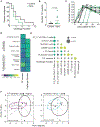Experimental bacterial dysbiosis with consequent immune alterations increase intrarectal SIV acquisition susceptibility
- PMID: 36848230
- PMCID: PMC9989505
- DOI: 10.1016/j.celrep.2023.112020
Experimental bacterial dysbiosis with consequent immune alterations increase intrarectal SIV acquisition susceptibility
Abstract
Variations in the composition of the intestinal bacterial microbiome correlate with acquisition of some sexually transmitted pathogens. To experimentally assess the contribution of intestinal dysbiosis to rectal lentiviral acquisition, we induce dysbiosis in rhesus macaques (RMs) with the antibiotic vancomycin prior to repeated low-dose intrarectal challenge with simian immunodeficiency virus (SIV) SIVmac239X. Vancomycin administration reduces T helper 17 (TH17) and TH22 frequencies, increases expression of host bacterial sensors and antibacterial peptides, and increases numbers of transmitted-founder (T/F) variants detected upon SIV acquisition. We observe that SIV acquisition does not correlate with measures of dysbiosis but rather associates with perturbations in the host antimicrobial program. These findings establish a functional association between the intestinal microbiome and susceptibility to lentiviral acquisition across the rectal epithelial barrier.
Keywords: CP: Immunology; CP: Microbiology; HIV; SIV; T(H)17; T(H)22; macaque; men who have sex with men; microbiome.
Published by Elsevier Inc.
Conflict of interest statement
Declaration of interests The authors declare no competing interests.
Figures



Similar articles
-
Intragastric Administration of Lactobacillus plantarum and 2,2'-Dithiodipyridine-Inactivated Simian Immunodeficiency Virus (SIV) Does Not Protect Indian Rhesus Macaques from Intrarectal SIV Challenge or Reduce Virus Replication after Transmission.J Virol. 2018 Apr 27;92(10):e02030-17. doi: 10.1128/JVI.02030-17. Print 2018 May 15. J Virol. 2018. PMID: 29491157 Free PMC article.
-
Antiretroviral Therapy Administration in Healthy Rhesus Macaques Is Associated with Transient Shifts in Intestinal Bacterial Diversity and Modest Immunological Perturbations.J Virol. 2019 Aug 28;93(18):e00472-19. doi: 10.1128/JVI.00472-19. Print 2019 Sep 15. J Virol. 2019. PMID: 31270225 Free PMC article.
-
The Frequency of Vaccine-Induced T-Cell Responses Does Not Predict the Rate of Acquisition after Repeated Intrarectal SIVmac239 Challenges in Mamu-B*08+ Rhesus Macaques.J Virol. 2019 Feb 19;93(5):e01626-18. doi: 10.1128/JVI.01626-18. Print 2019 Mar 1. J Virol. 2019. PMID: 30541854 Free PMC article.
-
Walk on the wild side: SIV infection in African non-human primate hosts-from the field to the laboratory.Front Immunol. 2023 Jan 12;13:1060985. doi: 10.3389/fimmu.2022.1060985. eCollection 2022. Front Immunol. 2023. PMID: 36713371 Free PMC article. Review.
-
Localization of Simian immunodeficiency virus-infected cells in the genital tract of male and female Rhesus macaques.J Reprod Immunol. 1998 Dec;41(1-2):331-9. doi: 10.1016/s0165-0378(98)00069-2. J Reprod Immunol. 1998. PMID: 10213321 Review.
Cited by
-
Untangling the role of the microbiome across the stages of HIV disease.Curr Opin HIV AIDS. 2024 Sep 1;19(5):221-227. doi: 10.1097/COH.0000000000000870. Epub 2024 Jul 24. Curr Opin HIV AIDS. 2024. PMID: 38935047 Free PMC article. Review.
-
Deciphering HIV-associated inflammation: microbiome's influence and experimental insights.Curr Opin HIV AIDS. 2024 Sep 1;19(5):228-233. doi: 10.1097/COH.0000000000000866. Epub 2024 Jun 18. Curr Opin HIV AIDS. 2024. PMID: 38884255 Free PMC article. Review.
-
HIV, asymptomatic STI, and the rectal mucosal immune environment among young men who have sex with men.PLoS Pathog. 2023 May 30;19(5):e1011219. doi: 10.1371/journal.ppat.1011219. eCollection 2023 May. PLoS Pathog. 2023. PMID: 37253061 Free PMC article.
References
-
- UNAIDS (2020). UNAIDS Data 2020. Report. https://www.unaids.org/en/resources/documents/2020/unaids-data.
-
- Cohen CR, Lingappa JR, Baeten JM, Ngayo MO, Spiegel CA, Hong T, Donnell D, Celum C, Kapiga S, Delany S, and Bukusi EA (2012). Bacterial vaginosis associated with increased risk of female-to-male HIV-1 transmission: a prospective cohort analysis among African couples. PLoS Med. 9, e1001251. 10.1371/journal.pmed.1001251. - DOI - PMC - PubMed
Publication types
MeSH terms
Substances
Grants and funding
LinkOut - more resources
Full Text Sources
Miscellaneous

